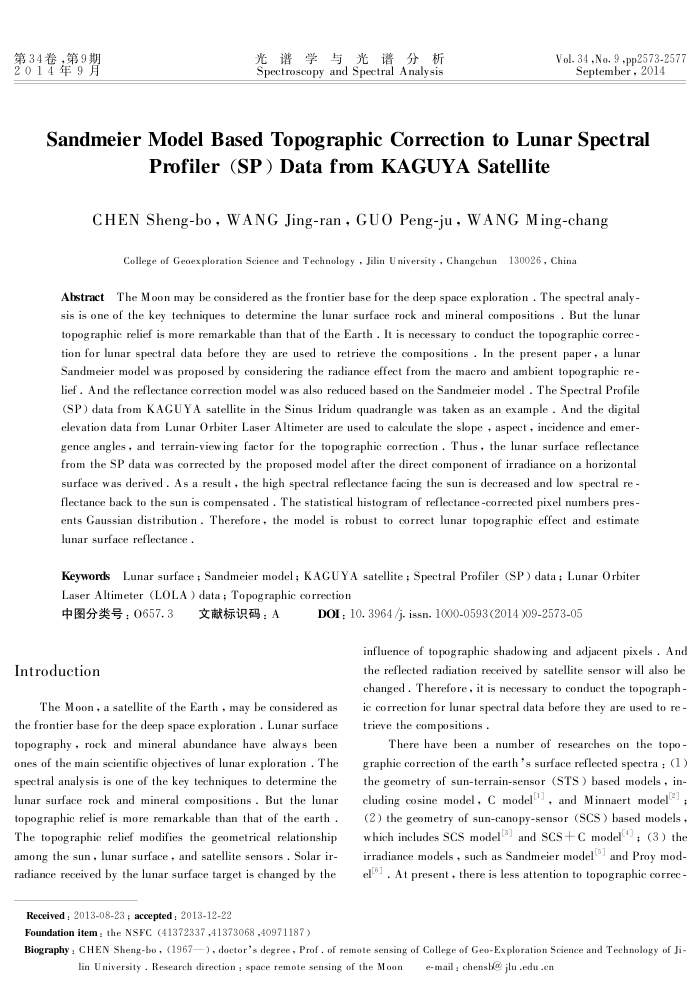基于Sandmeier模型的月球KAGUYA卫星高光谱数据地形校正
内容简介
 第34卷,第9期 2014年9月
第34卷,第9期 2014年9月光谱学与光谱分析 Spectroscopy and Spectral Analysis
Vol. 34,No. 9 -pp2573-2577 September, 2014
Sandmeier Model Based Topographic Correction to Lunar Spectral
Profiler(SP)Data fromKAGUYA Satellite
CHEN Sheng-bo,WANG Jing-ran,GUO Peng-ju,WANG Ming-chang
College of Geoexploration Science and Technology , Jilin U niversity , Changchun130026, China
Abstract The Moon may be considered as the frontier base for the deep space exploration . The spectral analy-sis is one of the key techniques to determine the lunar surface rock and mineral compositions . But the lunar topographic relief is more remarkable than that of the Earth . It is necessary to conduct the topographic correc tion for lunar spectral data before they are used to retrieve the compositions . In the present paper, a lunar Sandmeier model w as proposed by considering the radiance effect from the macro and ambient topographic re. lief . And the reflectance correction model was also reduced based on the Sandmeier model . The Spectral Profile(SP) data from KAGUYA satellite in the Sinus Iridum quadrangle was taken as an example . And the digital elevation data from Lunar Orbiter Laser Altimeter are used to calculate the slope , aspect , incidence and emer-gence angles, and terrain-viewing factor for the topographic correction . Thus , the lunar surface reflectance from the SP data was corrected by the proposed model after the direct component of iradiance on a horizontal surface was derived . A s a result , the high spectral reflectance facing the sun is decreased and low spectral re flectance back to the sun is compensated . The statistical histogram of reflectance -corrected pixel numbers pres ents Gaussian distribution . Therefore , the model is robust to correct lunar topographic effect and estimate lunar surface reflectance
Keywords Lunar surface ; Sandmeier model ; KAGUYA satellite ; Spectral Profiler (SP) data : Lunar Orbiter Laser Altimeter (LOLA ) data : Topographic correction
中图分类号:0657.3
Introduction
文献标识码:A
DOI: 10. 3964/j. issn. 1000-0593(2014 )09-2573-05
influence of topographic shadowing and adjacent pixels . And the reflected radiation received by satellite sensor will also be changed . Therefore , it is necessary to conduct the topograph
The Moon , a satellite of the Earth , may be considered as the frontier base for the deep space exploration . Lunar surface topography , rock and mineral abundance have always been ones of the main scientific objectives of lunar exploration . The spectral analysis is one of the key techniques to determine the lunar surface rock and mineral compositions .But the lunar topographic relief is more remarkable than that of the earth . The topographic relief modifies the geometrical relationship among the sun, lunar surface , and satellite sensors . Solar ir-radiance received by the lunar surface target is changed by the
Received : 2013-08-23 ; accepted: 2013-12-22
Foundation item : the NSFC (41372337 ,41373068 ,40971187)
ic correction for lunar spectral data before they are used to re -trieve the compositions .
There have been a number of researches on the topo-graphic correction of the earth 's surface reflected spectra : (1) the geometry of sun-terrain-sensor (STS ) based models , in-cluding cosine model, C model] , and Minnaert model2] ;(2) the geometry of sun-canopy-sensor (SCS ) based models , which includes SCS model[8] and SCS + C model[ ; (3) the irradiance models , such as Sandmeier model[] and Proy mod-el[] . At present , there is less attention to topographic correc
Biography : CHEN Sheng-bo , (1967—), doctor's degree , Prof . of remote sensing of College of Geo-Exploration Science and Technology of Ji-
lin University . Research direction : space remote sensing of the Moon
e-mail : chensb@ jlu .edu -cn